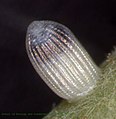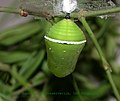Tirumala septentrionis
| Dark blue tiger | |
|---|---|

| |

| |
| Male underside both T. s. dravidarum Kerala, India | |
| Scientific classification | |
| Domain: | Eukaryota |
| Kingdom: | Animalia |
| Phylum: | Arthropoda |
| Class: | Insecta |
| Order: | Lepidoptera |
| Family: | Nymphalidae |
| Genus: | Tirumala |
| Species: | T. septentrionis
|
| Binomial name | |
| Tirumala septentrionis (Butler, 1874)
| |
Tirumala septentrionis, the dark blue tiger,[1][2] is a danaid butterfly found in the Indian subcontinent and Southeast Asia.[1][2]
Description
[edit]This section may need to be rewritten to comply with Wikipedia's quality standards, as this description is mainly just a list of differences between this and T. liminiace; it should be described independently in its own terms. (September 2024) |
Tirumala septentrionis has a wingspan from 80–115 mm.[3][4] The species closely resembles Tirumala limniace, but is sufficiently distinct to be easily recognized, even on the wing. Compared to T. limniace, its upperside is darker and the semihyaline markings are narrower, more distinct, and of a bluer tint. In the forewing, in interspace 1 the two streaks are narrower, never coalescent, and the upper streak forms an oval detached spot; the short streaks above vein 5 are outwardly never truncate, always acute. In the hindwing, the two streaks of the discoidal cell united at base are wide apart at their apices, with the lower streak never formed into a hook. On the underside, this species is generally darker, the apex of the forewing and the whole of the ground colour of the hindwing not being of the conspicuous golden brown that they are in T. limniace.[3][4]
Distribution
[edit]The Himalayas from Simla to Sikkim, into Assam, Myanmar, Cambodia and Southeast Asia; Odisha; West Bengal, southern India, the Western Ghats and Nilgiris; Sri Lanka.[1][2]
Habits
[edit]This species is one of the most dominant, making up 78% of the population during the migratory season in southern India, where many species undertake migration. Both males and females seem to migrate in equal proportions.[5]
Life cycle
[edit]Caterpillar is similar to that of T. limniace (see Journal of the Bombay Natural History Society x, 1896, p. 240). It is said by MacKinnon and de Nicéville to feed on Vallaris dichotoma (Journal of the Bombay Natural History Society xi, 1807, p. 212).[3] Other species include Cosmostigma racemosa,[6] Heterostemma brownii and Cocculus species.[7]
-
Egg
-
Caterpillar
-
Pupa
-
Male T. s. septrionis
See also
[edit]References
[edit]- ^ a b c Varshney, R.K.; Smetacek, Peter (2015). A Synoptic Catalogue of the Butterflies of India. New Delhi: Butterfly Research Centre, Bhimtal & Indinov Publishing. p. 151. doi:10.13140/RG.2.1.3966.2164. ISBN 978-81-929826-4-9.
- ^ a b c Savela, Markku. "Tirumala septentrionis (Butler, 1874)". Lepidoptera and Some Other Life Forms. Retrieved July 3, 2018.
- ^ a b c
 One or more of the preceding sentences incorporates text from this source, which is in the public domain: Bingham, Charles Thomas (1907). Fauna of British India. Butterflies Vol. 2. Taylor & Francis. p. 17.
One or more of the preceding sentences incorporates text from this source, which is in the public domain: Bingham, Charles Thomas (1907). Fauna of British India. Butterflies Vol. 2. Taylor & Francis. p. 17.
- ^ a b
 One or more of the preceding sentences incorporates text from this source, which is in the public domain: Moore, Frederic (1890–1892). Lepidoptera Indica. Vol. I. London: Lovell Reeve and Co. pp. 34–36.
One or more of the preceding sentences incorporates text from this source, which is in the public domain: Moore, Frederic (1890–1892). Lepidoptera Indica. Vol. I. London: Lovell Reeve and Co. pp. 34–36.
- ^ Kunte, K. 2005. Species composition, sex-ratios and movement patterns in Danaine butterfly migrations in southern India. Journal of the Bombay Natural History Society 102(3):280-286
- ^ Nair, P. V. 2005. Cosmostigma racemosa, a new host plant record of the Dark Blue Tiger Butterfly Tirumala septentrionis from Kerala. Journal of the Bombay Natural History Society. 102(3):354
- ^ Gaden S. Robinson, Phillip R. Ackery, Ian J. Kitching, George W. Beccaloni and Luis M. Hernández HOSTS - A Database of the World's Lepidopteran Hostplants [1] Accessed October 2006
External links
[edit]- Sri Lanka Wild Life Information Database Archived 2011-07-18 at the Wayback Machine




